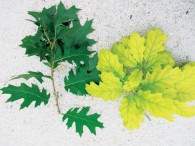
Dead trees in Stapleton
For years my family wondered about our poor backyard tree, whose leaves are forever yellow. It looms outside our house in a constant state of autumn, despite our efforts to save it from dying. Many of our park trees are in the same boat—dying en masse without fanfare or glaring reason. Often their deaths aren’t right after planting, but come after years to a decade of growing familiar. What causes their decline, and how can we help?
In our high elevation climate, trees can die from events beyond our control, like drought or late-winter freezes. Or they croak because of us, from overwatering or planting too deep. Or they die for a combination of factors or reasons unknown. Because urban tree demise is hard to sleuth, below we’ll address some common tree afflictions and solutions.
Like most problems, it helps to start at the root, and here that means in our infamous dirt. Clay dominates many Colorado soils. Thus they drain poorly. In lawns this spells trouble for conifers like pines and spruces, because grasses need more water than such trees can handle. Soggy ground and compacted earth are a double-whammy for most trees, because such conditions asphyxiate their roots.
Clay soils also have high pH, meaning they are basic or the opposite of acidic. High pH causes a classic Colorado problem—“iron chlorosis.” Its hallmark is bright yellow leaves with dark green veins, found all summer long, not just in fall. Overwatering in spring exacerbates this yellowing. Soil or tree treatments have limited success in solving this affliction. Oaks and maples (the tree in our backyard) are particularly susceptible to chlorosis—some trees can survive it but most linger and fail.
Even if there’s a good match between tree species and soils, a tree’s problems often begin with how it’s planted. A common misconception is that tree roots grow straight down, deep into the ground. Au contraire, many roots spread horizontally just beneath the surface. Thus trees planted in narrow, deep holes, especially in clay soil, may end up strangled by their own roots. Years after planting, the roots try to spread but encounter dense clay soils around their planting-hole. As roots try to spread they are rebuffed, instead turning again and again, burrowing through the looser soil in the hole. Repeatedly they circle the tree’s root ball, “girdling” the tree trunk like a strangulating boa.
Insects are opportunistic urban tree killers. A common one in Colorado snuffs street trees by the dozens—especially ashes. A friend showed me the clue—tiny sawdusty holes in bark at knee-to-chest height. Inside these holes were the larvae of clearwing moths. These caterpillar-like larvae were having a feast, boring through the tree’s innards and cutting off its vascular systems.
But why some trees and not others? Clearwings love trees whose bark has been nicked by weed-whackers and mowers. But why do insects infest such trees in the first place? Many are exploiting trees that are weak. Trees might be weakened from natural causes like extreme weather or poor soil poor drainage. Or weary from battling man-made issues like lawnmoweritis, compacted soil, overwatering, or overdeep planting. With weakened systems trees slowly succumb to insect attacks, microscopic pests, hard freezes and droughts.

Healthy (green) and sick (yellow) leaves of the northern red oak tree, illustrating leaves yellowed and dwarfed by lack of iron in its diet. This condition, “iron chlorosis,” is common in Colorado’s clay soils, where tree roots cannot uptake available iron.
What can you do to help your own trees, or those in your community? In yards or parkways, don’t plant trees in grassy lawn areas—instead plant them in beds or with a mulch ring. Dig a wide shallow hole, not a deep narrow one. Don’t plant them deeply—make sure you can see their trunk bases flare out so they can be planted flush with the soil line. Pick ones that’ll thrive in your site’s conditions. Handy guides are at www.coloradotrees.org/find.php or www.cmg.colostate.edu/gardennotes.shtml. For park and street trees, ask your HOA or parks department to plant trees adapted to local conditions (e.g., water-tolerant species in sopping areas) or to change the environment’s characteristics (e.g., install beds or mulch, re-grade to promote drainage). Avoid replacing trees with the same species, unless site issues have been resolved.

Green ash bark with exit holes from the larvae of clearwing moths. Attracted to tree wounds, these caterpillar-like creatures eat innards of trees, slowly chewing away all the nutrient-carrying pipes just below the bark’s surface. They spread particularly easily when the trees are weakened or arranged in rows.
For most ailing urban trees, there is no silver bullet. Sprays or magic powders won’t solve most problems. Rather every tree needs a steward, who invests beforehand and with later-in-life care. Trees need someone to keep an eye on them, in case trouble arises. Tap your inner Lorax and see if your trees are in need.
James W. Hagadorn, Ph.D., is a scientist at the Denver Museum of Nature & Science. Suggestions and comments welcome at jwhagadorn@dmns.org.




0 Comments